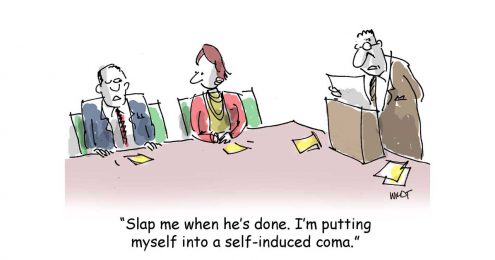“I have a terrible board.”
This is one of the most common refrains I hear from nonprofit staff leaders… and even from board members! I have asked clients if they were to start from scratch, how many board members would they keep? The number is often low. Sometimes the number is zero.
I listen empathetically (my job), but I don’t let them off the hook. I ask a series of questions that help nonprofit leaders, board, and staff understand that they don’t have terrible boards.
It is possible that they have a few ‘terrible’ board members. But that is different. And not only is that common, it is something you should expect.
Every board has 1 or more difficult board members.
Oh, I just saw your head drop into your hands. Please stay with me.
Let’s define what this looks like, and then I have some very practical advice to uplevel your board…
THE PROFILE OF THE DIFFICULT BOARD MEMBER
Difficult board members are like anchors when it comes to your nonprofit. And not in a good way. They can hold your board and your organization down and slow down your journey toward your mission.
There are a variety of kinds of difficult board members. And for some, “difficult” may be an understatement.
- The Toxic Board Members
These folks can be ‘negative Nancys’ or worse. They can hold grudges when votes don’t go their way. They challenge disrespectfully. They have opinions with no basis in fact. They are unprepared and complain that they don’t have what they need to be good at their jobs. You get the idea. - Overstepping Board Members
These board members often mean well and sometimes they don’t. They cross the line and direct the activities of staff. A problem because of power dynamics. Very hard to say no to a board member. You can do a chiropractic adjustment with some board members and educate them; others not so much. The “not so much” folks are kinda terrible. - MIA Board Members
Requires little explanation. If you have any trouble remembering what these board members look like, that’s a clear sign you have a board member who is just plain absent. - The Board Member Who Crosses a Serious Line
I note them here only because you must initiate action to remove the ‘terribles’ who cross serious lines. Inappropriate use of funds, use of board service for personal financial benefit, and inappropriate actions with other board or staff that could seriously jeopardize the public relations of the organization. These folks have to go and the board chair and ED have to have that difficult conversation for the greater good of the organization. That said, for our purposes today, we’ll leave these folks and the strategy for proactively moving them out for another blog post.
For today’s purposes, we are going to place all these folks, “Toxic,” “Overstepping,” and “MIA” in one bucket. Let’s just use a technical term.
Dead weight.
DID I HEAR YOU SAY ALL BOARDS HAVE DEAD WEIGHT?
Yup. Every single board has someone who takes up space, has a bad attitude, or causes some kind of tsuris (trouble in Yiddish). Let’s talk about how much dead weight a typical board has.
Are you sitting down?
A pretty good board, a decent board, a better than average board, a Grade “B” board has ONE-THIRD dead weight. So a board of 18 could have as many as 6 dead weight board members.
But you don’t want a decent board. Your work demands a great board, a Grade A board.
Are you suggesting that I be complacent about my dead weight?
No. No. NO!
FOCUS ON THE RIGHT PEOPLE
Here’s the big lesson for today. Dead weight board members frustrate the heck out of you. They drain emotional energy from you that you really really need for the work. I want you to spend as little time as possible on the dead weight board members. That will be time (and energy) you can’t get back. Pick your battles, and try to make slight changes at the margins, but otherwise, let them be dead weight.
All your energy should be directed on leveling up your Grade A board members and most importantly investing in the folks in the middle.
ASSESS YOUR BOARD MEMBERS AS INDIVIDUALS
Back to what I said at the top. You do not have a terrible board. You have a group of individuals of varying skills, passion for the mission, motivation, and lived experience. You need to look at them as individuals.
Go through your list of board members. A spreadsheet or an old-fashioned piece of paper. Next to each board member’s name, follow these steps.
Step 1: Mark them an A, B, or C.
A = rockstar who initiates
B = willing to do something if asked
C = dead weight
Step 2: Separate your Bs
B+ = you can imagine them being an A if only…
B- = they are just north of a C
I promise you that when you finish this exercise, you will see that you don’t have a terrible board, and referring to it that way is a problem. Because you won’t invest in your board and you won’t invest in the right board members (and you’ll spend too much emotional energy on the Cs).
NOW HERE’S THE ADVICE THAT WILL PAY OFF — I PROMISE
- Be in regular contact with your As. Your As will always think they should be doing even more and so they need to feel really valued by the chair and ED. Do NOT under any circumstances take them for granted. You are probably already in touch with them because of the work they are doing but this is different. This is good old-fashioned appreciation.
- Focus on the B+ group. Come up with a finite project they will succeed at. As part of a committee or a special assignment. Something that is important to the organization. Ask them to present at a board meeting about that project to ‘strut their stuff.’ It could be two B+ board members working on this. They present, the project is complete, and that B+ feels the ‘feels’ that come with making a real contribution.
NOW WHAT?
The outcome of this effort will be clear and obvious:
- With appreciation, your As stay steady. Right where you want ’em. Rockstars.
- You have executed a strategy with your B+ board members that will convert some of them to A board members. That is the biggest and most important shift. Converting B+ to A board members.
- B- board members have a choice. They have just seen their B+ colleagues get all the spotlight and can see the value they can bring to the organization. You might just move them into the B+ category and you can then start the B+ strategy with them. The other option for the B- board member is to slide down into the C category. Maybe you gave that B- board member too high a grade.
- With more high-performing board members getting appreciation and feeling valued, you know what dead weight board members start to feel like? Dead weight.
This is the way to move dead weight, “terrible” board members out. This strategy makes them FEEL like dead weight and they begin to self-select off. They get busier, more MIA, another board comes along.
Bottom line is you can’t tell someone they are dead weight. They have to feel like dead weight, get uncomfortable about it, and when they feel uncomfortable, they will find their way to comfort by stepping aside.
IT WORKS
Remember. You do not have a terrible board. Please stop saying that to yourself, your staff, your spouse, your pet, or your imaginary friend. You have dead weight board members who need to feel like dead weight. You need to focus on the board members who have potential and have not yet ignited. You need to ignite them and work to convert them to high performers. Watch your dead weight board members self-select off. And voíla, you have raised the bar for successful board service.
That’s how it works. And it does. And you will spend more emotional energy with your B board members and your clients or your cause or your art, and you will find yourself with more gas in your tank for the work that matters. The work the world is counting on you to do.
Start transforming your board today with the help of my free workshop! Join me as we work together to design the perfect board that aligns with your mission and supports your organization’s success. With expert insights, practical strategies, and bonus resources like the Board Attributes Checklist and the Board Composition Matrix Spreadsheet, you’ll be well on your way to a brighter future for your nonprofit. So what are you waiting for? Sign up now and let’s get started!
Want to learn from a growing community of nonprofit leaders and get exclusive access to content from a variety of experts? Click here to learn more about the Nonprofit Leadership Lab.



